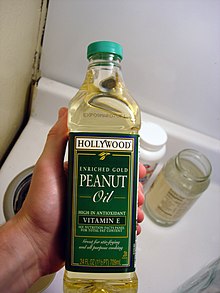Vegetaĵa oleo


Vegetaĵa oleo, foje nomita legoma oleo, estas organika kombinaĵo akirita el semoj aŭ aliaj partoj de la plantoj, en kies histoj ĝi akumuliĝas kiel fonto de energio.
Kelkaj ne taŭgas por homa konsumo, kiaj tiuj el ricino aŭ kotono.
Kiel ĉiu graso ĝi estas konstituita el glicerino kaj tri grasacidoj.
Legomaj oleoj estas partoj de vegetaĵaj oleoj, ĉar ili koncernas nur oleojn produktitajn de manĝeblaj ĝardenaj herbojn[1].
Fontoj[redakti | redakti fonton]
Vegetaĵa oleo devenas el fruktoj aŭ semoj de oleplantoj, kiaj:
- La olivo (frukto el olivarbo) nome la olivoleo
- La sunfloro
- La sojo
- La palmo, kaj el ties frukto kaj el ties kerno.
- La sezamo nome la sezamoleo
- La ternukso el kio la arakida oleo
- La rizo
- La maizo el kio la maizoleo
- La lino
- La kartamo
- La kanabo
- La kolzo
- La migdalo
- La juglando
- La avelo
- La semoj de vinbero
- La semoj de papavo
- La semoj de kukurbo
Tipoj de vegetaĵaj oleoj[redakti | redakti fonton]
La termino povas rilati al diversaj specoj de vegetaĵaj oleoj:
- "nutraĵa oleo": uzata por manĝado;
- "vegetaĵa oleo-brulaĵo": uzata kiel brulaĵo aŭ kiel aldonaĵo en brulmotoroj;
- "vegetaĵa oleo": uzata por aliaj uzoj, ekzemple por lumigo (olelampo) aŭ kiel lubrikaĵo aŭ por rapide sekiĝanta farbo de pentristoj (linoleo);
- ankaŭ oleoj uzataj en kosmetiko aŭ eĉ en farmacio.el oficina kumino, vinbero-semoj, kokoso, buterarbo, lino, asaio, bertoletio ktp.
La produktado de vegetaĵaj oleoj originas el la jenaj ĉefaj oleplantoj (en 2012)[2] : palmo 35%, sojherbo 27%, kolzo 25%, sunfloro 10%, palmaj fruktokernoj 3%. La palmolearbo (Elaeis guineensis) havas altan rendimenton, ĉar ĝi provizas trionon de la monda produktado de vegetaĵaj oleoj disvastiĝante sur 7% de la kultivata areo de oleo-semoj.
Notoj kaj referencoj[redakti | redakti fonton]
Aliaj referencoj[redakti | redakti fonton]
- Beare-Rogers, J.L. (1983). “Trans and positional isomers of common fatty acids”, Advances in Nutritional Research 5, p. 171–200. doi:10.1007/978-1-4613-9937-7_8.
- Berry, E.M. and Hirsch, J. (1986). “Does dietary linolenic acid influence blood pressure?”, American Journal of Clinical Nutrition 44, p. 336–340.
- Beyers, E.C. and Emken, E.A. (1991). “Metabolites of cis, trans, and trans, cis isomers of linoleic acid in mice and incorporation into tissue lipids”, Biochimica et Biophysica Acta 1082, p. 275–284. doi:10.1016/0005-2760(91)90203-t.
- Birch, D.G., Birch, E.E., Hoffman, D.R., and Uauy, R.D. (1992). “Retinal development in very-low-birth-weight infants fed diets differing in omega-3 fatty acids”, Investigative Ophthalmology and Visual Science 33 (8), p. 2365–2376.
- Birch, E.E., Birch, D.G., Hoffman, D.R., and Uauy, R. (1992). “Dietary essential fatty acid supply and visual acuity development”, Investigative Ophthalmology and Visual Science 33 (11), p. 3242–3253.
- Brenner, R.R.. (1989) A.J. Vergroesen and M. Crawford: Factors influencing fatty acid chain elongation and desaturation, in the role of fats in human nutrition, 2‑a eldono, Academic Press, London, p. 45–79.
- "Report of the task force on trans fatty acids", British Nutrition Foundation.
- "Central Soya annual report".
- Emken, E. A. (1984). “Nutrition and biochemistry of trans and positional fatty acid isomers in hydrogenated oils”, Annual Reviews of Nutrition 4, p. 339–376. doi:10.1146/annurev.nutr.4.1.339.
- Enig, M.G., Atal, S., Keeney, M and Sampugna, J. (1990). “Isomeric trans fatty acids in the U.S. diet”, Journal of the American College of Nutrition 9, p. 471–486.
- Ascherio, A., Hennekens, C.H., Baring, J.E., Master, C., Stampfer, M.J. and Willett, W.C. (1994). “Trans fatty acids intake and risk of myocardial infarction”, Circulation 89, p. 94–101. doi:10.1161/01.cir.89.1.94.
- Gurr, M.I. (1983). “Trans fatty acids: Metabolic and nutritional significance”, Bulletin of the International Dairy Federation 166, p. 5–18.
- Hui Y. H.: Bailey's Industrial Oil and Fat Products.
- Koletzko, B. (1992). “Trans fatty acids may impair biosynthesis of long-chain polyunsaturates and growth in man”, Acta Paediatrica 81, p. 302–306. doi:10.1111/j.1651-2227.1992.tb12230.x.
- Lief, Alfred. (1958) It floats: The story of Procter & Gamble. Rinehart.
- MacMillen, Harold W.. (1967) Mr. Mac and Central Soya: the foodpower story. Newcomen Society.
- Marchand, C.M. (1982). “Positional isomers of trans-octadecenoic acids in margarine”, Canadian Institute of Food Science and Technology Journal 15, p. 196–199. doi:10.1016/s0315-5463(82)72537-4.
- Mensink, R.P., Zock, P.L., Katan, M.B. and Hornstra, G. (1992). “Effect of dietary cis-and trans-fatty acids on serum lipoprotein[a] levels in humans”, Journal of Lipid Research 33, p. 1493–1501.
- Siguel, E.N. and Lerman, R.H. (1993). “Trans fatty acid patterns in patients with angiographically documented coronary artery disease”, American Journal of Cardiology 71, p. 916–920. doi:10.1016/0002-9149(93)90906-s.
- Troisi, R., Willett, W.C. and Weiss, S.T. (1992). “Trans-fatty acid intake in relation to serum lipid concentrations in adult men”, American Journal of Clinical Nutrition 56, p. 1019–1024.
- Willett, W.C., Stampfer, M.J., Manson, J.E., Colditz, G.A., Speizer, F.E., Rosner, B.A., Sampson, L.A. and Hennekens, C.H. (1993). “Intake of trans fatty acids and risk of coronary heart disease among women”, The Lancet 341, p. 581–585. doi:10.1016/0140-6736(93)90350-p.
Bibliografio[redakti | redakti fonton]
- Gupta, Monoj K.. (2007) Practical guide for vegetable oil processing. AOCS Press, Urbana, Illinois. ISBN 978-1-893997-90-5.
- (2002) Jee, Michael: Oils and Fats Authentication. Blackwell Publishing, Oxford, England. ISBN 1-84127-330-9.
- Salunkhe, D.K., Chavan, J.K., Adsule, R.N. and Kadam, S.S.. (1992) World Oilseeds – Chemistry, Technology, and Utilization. Van Nostrand Reinhold, New York. ISBN 0-442-00112-6.
Eksteraj ligiloj[redakti | redakti fonton]
- Fats and Cholesterol: Out with the Bad, In with the Good – What Should You Eat? – The Nutrition Source – Harvard School of Public Health. www.hsph.harvard.edu. Arkivita el la originalo je 2011-04-27. Alirita 2009-05-04.
- Vegetable oil yields, characteristics: Journey to Forever. journeytoforever.org. Alirita 2009-05-04.
- National Non-Food Crops Centre. www.nnfcc.co.uk. Alirita 2009-05-04.
